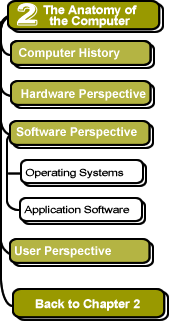

|
Operating Systems: Macintosh, Windows, and the GUI
Steve Jobs, cofounder of Apple computer, realized the how much of an obstacle the difficult command-line interface posed to the development of a truly "personal" computer rather than a computer for computer specialists. Apple had had enormous success with its Apple II, which debuted in 1977; however, they were losing market share to the IBM PC, which debuted in 1981. Like the DOS-driven PC, the Apple II's operating system had a command-line interface. While touring Xerox Corporation's Palo Alto Research Center (AKA "Xerox PARC"), Steve Jobs saw a demonstration of a graphical user interface (GUI) that Xerox had developed earlier in the 1970s for their Alto computer but then scrapped. Instead of requiring the user to learn arcane commands, the graphical user interface was much more intuitive: using a pointing device dubbed a "mouse," the user could pick options from menus and was guided by graphics and icons that created the look and feel of working on a desktop. Moreover, when software programs ran, they ran inside "windows," frames on the screen that could be shuffled around the virtual "desktop" as easily and as familiarly as stacking and shuffling pieces of paper on a real desk. Steve Jobs was stunned by what he saw: "Within 10 minutes, I realized that someday all computers would work this way," he would later say. After the visit to PARC, Jobs went back to Apple and began work on the Macintosh.
Steve Jobs described the Macintosh as "a computer for the rest of us," and he debuted the "Mac" in 1984 with a famous ad campaign that compared the prospect of an IBM-dominated world with the nightmarish vision of the future portrayed in George Orwell's novel, 1984. In contrast, the Macintosh displayed an icon of a smiling face when it was started up, enabled the creation of elegant text, and could play beautiful sounds. Best of all, the Macintosh operating system ("MacOS") sported a user-friendly graphical user interface.
Microsoft, the manufacturer of DOS, knew that the days of the command-line interface operating system were numbered. They quickly developed their own GUI operating system, which they named "Windows," and released it in 1985. Early versions of Microsoft Windows were very poor by comparison to the Macintosh operating system. Nevertheless, Apple was so alarmed by the similarity to their own GUI that they sued Microsoft. It took 7 years before the lawsuit was resolved in favor of Microsoft, in large part because of the work pre-dating Apple's GUI that had been produced at Xerox PARC. Meanwhile, Microsoft had continued to refine Windows, and over the course of the 1990s Microsoft Windows became the dominant operating system of the personal computer industry.
Apple, in turn, struggled during the 1990s, and, as one of a series of frantic moves, Steve Jobs was driven from the company. In the late 1990s, however, when Apple was in danger of complete collapse, Jobs was brought back to help save the company. In a stunning turnaround, Jobs led Apple back from the brink, introducing an impressive line of new Macintoshes, including the iMac. However, from the very beginning, Apple's best product was its operating system; accordingly, many were predicting that Apple's renaissance in the new millennium could not be judged to be complete until Apple delivered its much-anticipated new operating system: OS X (pronounced "oh-ess ten") in 2001, a year that calls to mind another famous novel.
![]()
![]()
These pages were written by Steven H. VanderLeest and Jeffrey Nyhoff and edited by Nancy Zylstra
©2005 Calvin University (formerly Calvin College), All Rights Reserved
If you encounter technical errors, contact computing@calvin.edu.